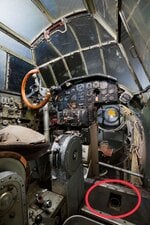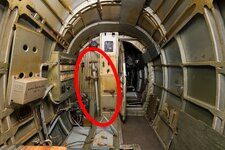The Stannum Liberator
Airman
Someone asked me a while ago if I could put any information on the Swedish service of the Ju86K, or the B3 in Swedish service.
I'm including quotations from Mikael Forslund's Swedish Bomber Colours.
The Junkers Ju86K B 3, had a length of 15.5 m, a height of 4.9 m, a wingspan of 22.7 m, a maximum weight of 8,200 kg. The Cruising speed is 315 km/h which would allow for flight for about 3 hours, travelling 1,070 km with the B3C. The fuel tank could hold 1,500 liters of Gas. The plane had a service ceiling of 7,000m. The B 3 in all variations would continue in Swedish service from 1936-1958. It would be used as a medium bomber, a surveillance aircraft, and later as a troop transport.
They had a horrible track record with 19 out of the 56 aircraft being written off in crashes.
The Maximum Speeds of the different variants:
B 3 (Junkers 86A-1, using two 760 h.p. Pratt & Whitney Hornet S1E-G)-298 km/h
B 3A (Junkers Ju86K-4 using two 745 h.p. NOHAB Mercury III engines (License built Bristol Mercury III's) -315 km/h
B 3B (Junkers Ju86K-5 using two 880 h.p. NOHAB Mercury XII engines (License built Bristol Mercury XII's) -325 km/h
B 3C (Junkers Ju86K-13 using two 980 h.p. NOHAB Mercury XXIV engines (License built Briston Mercury XXIV's) -372 km/h
B 3D (Junkers Ju86K-13 using two 905 h.p. Bristol Pegasus XIX engines (bought from the Germans, the engines were Polish war booty, illegal purchase)-360 km/h
Crew: "B3 crew consisted of four; apart from the pilot, an observer/bomb aimer was located in the front turret, where he also was to man the front machine gun. A new personnel category was also introduced with the radio operator, whose main job was to stay in touch with ground stations as well as other aircraft. The radio operator was also to operate the machine gun in the retractable lower gun turret. This was usually known as Signalistholken (the radio operators nesting box). The radio operator would also assist the pilot in navigational duties, and establishing the position of the aircraft through cross bearings. During long range reconnaissance flights, the radio operator was to take photographs, using the hand-held HK 25 camera. The fourth crew member, usually a conscript, was an aerial gunner, operating the dorsal machine gun. The B3 could easily be fitted with a second set of controls, which made instructor/trainee pilot flights possible."
My Contact at the Flygvapenmuseum (Swedish Airforce Museum) was unaware of the second set of controls, but they are clearly visible in some photos taken from the inside of the plane inside the museum. (Photos Attached)


I think this is a good starting point, if anyone has any inquiries feel free to ask and I will do my best to answer!
p.s.I also have some neat stories about their use in the war.
I'm including quotations from Mikael Forslund's Swedish Bomber Colours.
The Junkers Ju86K B 3, had a length of 15.5 m, a height of 4.9 m, a wingspan of 22.7 m, a maximum weight of 8,200 kg. The Cruising speed is 315 km/h which would allow for flight for about 3 hours, travelling 1,070 km with the B3C. The fuel tank could hold 1,500 liters of Gas. The plane had a service ceiling of 7,000m. The B 3 in all variations would continue in Swedish service from 1936-1958. It would be used as a medium bomber, a surveillance aircraft, and later as a troop transport.
They had a horrible track record with 19 out of the 56 aircraft being written off in crashes.
The Maximum Speeds of the different variants:
B 3 (Junkers 86A-1, using two 760 h.p. Pratt & Whitney Hornet S1E-G)-298 km/h
B 3A (Junkers Ju86K-4 using two 745 h.p. NOHAB Mercury III engines (License built Bristol Mercury III's) -315 km/h
B 3B (Junkers Ju86K-5 using two 880 h.p. NOHAB Mercury XII engines (License built Bristol Mercury XII's) -325 km/h
B 3C (Junkers Ju86K-13 using two 980 h.p. NOHAB Mercury XXIV engines (License built Briston Mercury XXIV's) -372 km/h
B 3D (Junkers Ju86K-13 using two 905 h.p. Bristol Pegasus XIX engines (bought from the Germans, the engines were Polish war booty, illegal purchase)-360 km/h
Crew: "B3 crew consisted of four; apart from the pilot, an observer/bomb aimer was located in the front turret, where he also was to man the front machine gun. A new personnel category was also introduced with the radio operator, whose main job was to stay in touch with ground stations as well as other aircraft. The radio operator was also to operate the machine gun in the retractable lower gun turret. This was usually known as Signalistholken (the radio operators nesting box). The radio operator would also assist the pilot in navigational duties, and establishing the position of the aircraft through cross bearings. During long range reconnaissance flights, the radio operator was to take photographs, using the hand-held HK 25 camera. The fourth crew member, usually a conscript, was an aerial gunner, operating the dorsal machine gun. The B3 could easily be fitted with a second set of controls, which made instructor/trainee pilot flights possible."
My Contact at the Flygvapenmuseum (Swedish Airforce Museum) was unaware of the second set of controls, but they are clearly visible in some photos taken from the inside of the plane inside the museum. (Photos Attached)


I think this is a good starting point, if anyone has any inquiries feel free to ask and I will do my best to answer!
p.s.I also have some neat stories about their use in the war.
